Report on Self-Reflection and Laissez-Faire Leadership Style
VerifiedAdded on 2023/06/09
|7
|1235
|295
Report
AI Summary
This report provides a self-reflection on laissez-faire leadership, examining its characteristics and importance, particularly in academic settings. It highlights the leader's capabilities in empowering team members and allocating resources effectively. The report identifies the leader's strengths, such as effective decision-making with team input, and weaknesses, including communication and time management skills. An action plan is presented to address these weaknesses, focusing on improving communication through active participation in discussions and enhancing time management by creating and adhering to a detailed schedule. The report concludes by emphasizing the significance of laissez-faire leadership in fostering employee development and participation in decision-making.
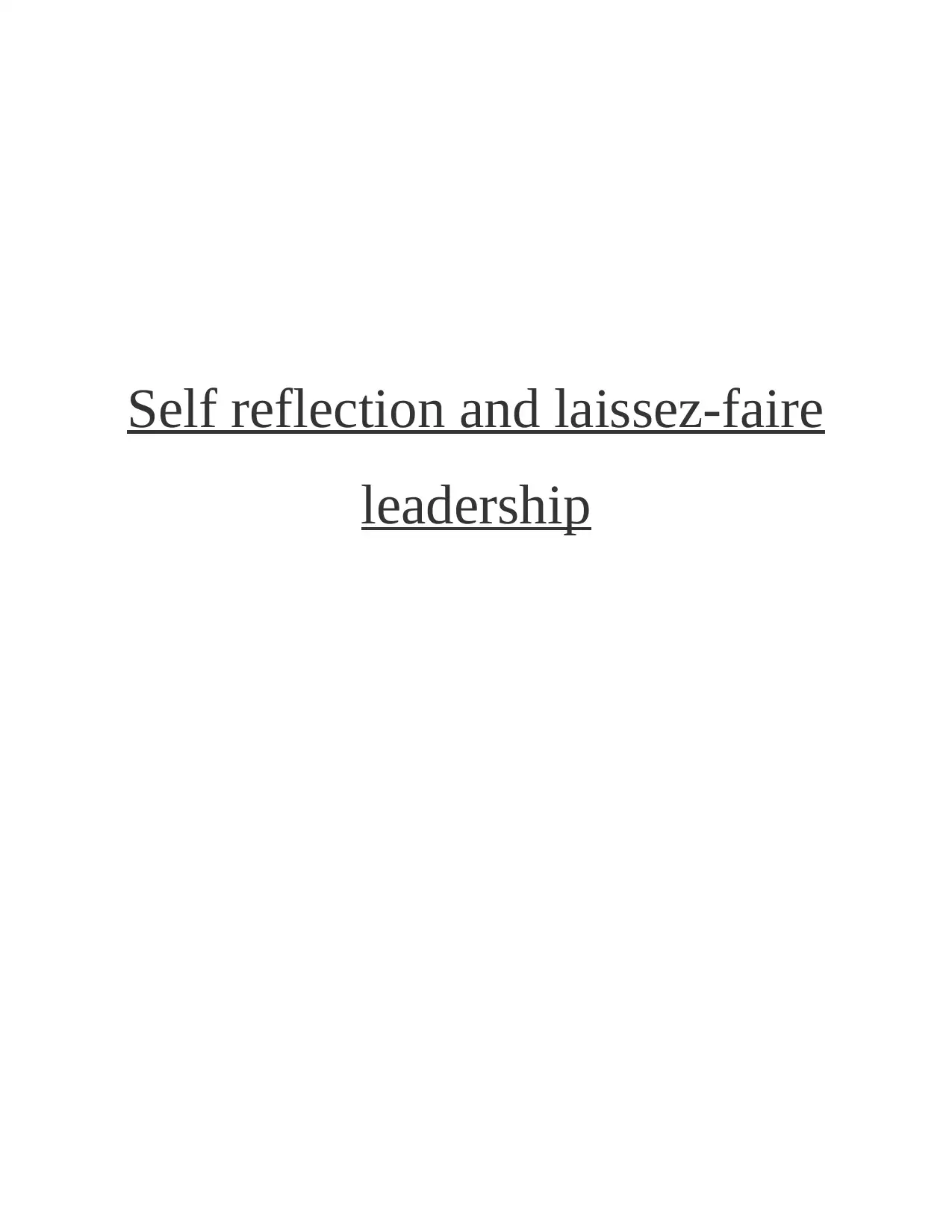
Self reflection and laissez-faire
leadership
leadership
Paraphrase This Document
Need a fresh take? Get an instant paraphrase of this document with our AI Paraphraser
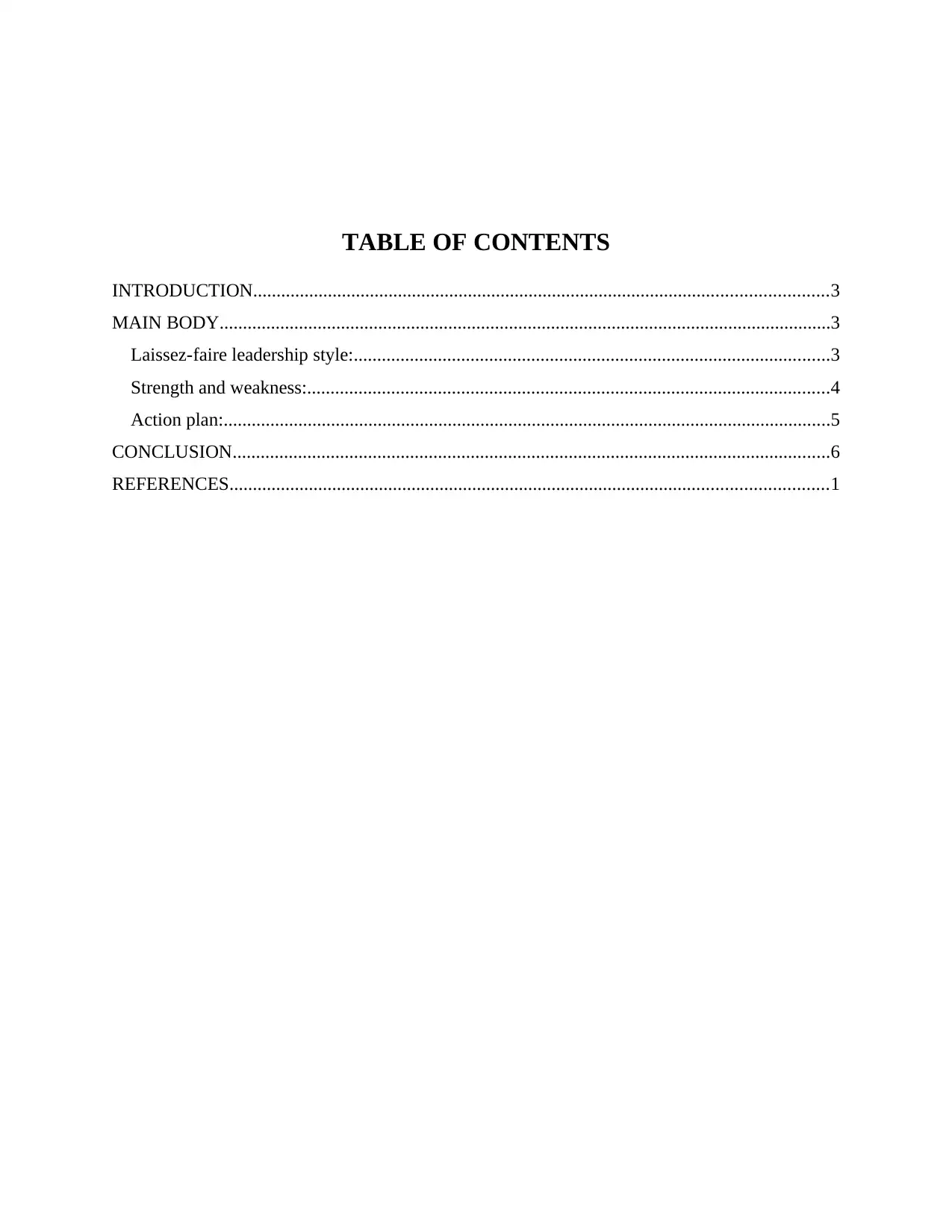
TABLE OF CONTENTS
INTRODUCTION...........................................................................................................................3
MAIN BODY...................................................................................................................................3
Laissez-faire leadership style:......................................................................................................3
Strength and weakness:................................................................................................................4
Action plan:..................................................................................................................................5
CONCLUSION................................................................................................................................6
REFERENCES................................................................................................................................1
INTRODUCTION...........................................................................................................................3
MAIN BODY...................................................................................................................................3
Laissez-faire leadership style:......................................................................................................3
Strength and weakness:................................................................................................................4
Action plan:..................................................................................................................................5
CONCLUSION................................................................................................................................6
REFERENCES................................................................................................................................1
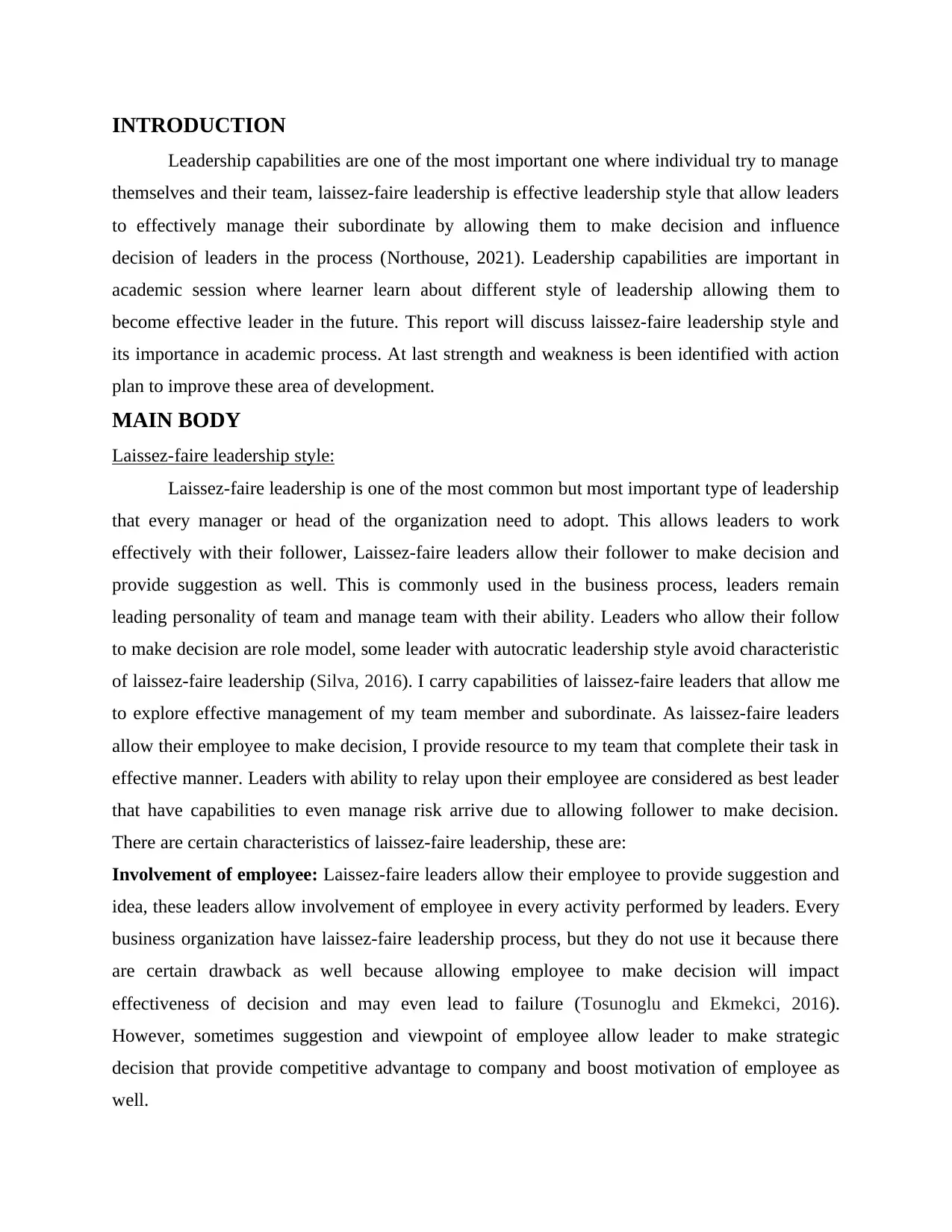
INTRODUCTION
Leadership capabilities are one of the most important one where individual try to manage
themselves and their team, laissez-faire leadership is effective leadership style that allow leaders
to effectively manage their subordinate by allowing them to make decision and influence
decision of leaders in the process (Northouse, 2021). Leadership capabilities are important in
academic session where learner learn about different style of leadership allowing them to
become effective leader in the future. This report will discuss laissez-faire leadership style and
its importance in academic process. At last strength and weakness is been identified with action
plan to improve these area of development.
MAIN BODY
Laissez-faire leadership style:
Laissez-faire leadership is one of the most common but most important type of leadership
that every manager or head of the organization need to adopt. This allows leaders to work
effectively with their follower, Laissez-faire leaders allow their follower to make decision and
provide suggestion as well. This is commonly used in the business process, leaders remain
leading personality of team and manage team with their ability. Leaders who allow their follow
to make decision are role model, some leader with autocratic leadership style avoid characteristic
of laissez-faire leadership (Silva, 2016). I carry capabilities of laissez-faire leaders that allow me
to explore effective management of my team member and subordinate. As laissez-faire leaders
allow their employee to make decision, I provide resource to my team that complete their task in
effective manner. Leaders with ability to relay upon their employee are considered as best leader
that have capabilities to even manage risk arrive due to allowing follower to make decision.
There are certain characteristics of laissez-faire leadership, these are:
Involvement of employee: Laissez-faire leaders allow their employee to provide suggestion and
idea, these leaders allow involvement of employee in every activity performed by leaders. Every
business organization have laissez-faire leadership process, but they do not use it because there
are certain drawback as well because allowing employee to make decision will impact
effectiveness of decision and may even lead to failure (Tosunoglu and Ekmekci, 2016).
However, sometimes suggestion and viewpoint of employee allow leader to make strategic
decision that provide competitive advantage to company and boost motivation of employee as
well.
Leadership capabilities are one of the most important one where individual try to manage
themselves and their team, laissez-faire leadership is effective leadership style that allow leaders
to effectively manage their subordinate by allowing them to make decision and influence
decision of leaders in the process (Northouse, 2021). Leadership capabilities are important in
academic session where learner learn about different style of leadership allowing them to
become effective leader in the future. This report will discuss laissez-faire leadership style and
its importance in academic process. At last strength and weakness is been identified with action
plan to improve these area of development.
MAIN BODY
Laissez-faire leadership style:
Laissez-faire leadership is one of the most common but most important type of leadership
that every manager or head of the organization need to adopt. This allows leaders to work
effectively with their follower, Laissez-faire leaders allow their follower to make decision and
provide suggestion as well. This is commonly used in the business process, leaders remain
leading personality of team and manage team with their ability. Leaders who allow their follow
to make decision are role model, some leader with autocratic leadership style avoid characteristic
of laissez-faire leadership (Silva, 2016). I carry capabilities of laissez-faire leaders that allow me
to explore effective management of my team member and subordinate. As laissez-faire leaders
allow their employee to make decision, I provide resource to my team that complete their task in
effective manner. Leaders with ability to relay upon their employee are considered as best leader
that have capabilities to even manage risk arrive due to allowing follower to make decision.
There are certain characteristics of laissez-faire leadership, these are:
Involvement of employee: Laissez-faire leaders allow their employee to provide suggestion and
idea, these leaders allow involvement of employee in every activity performed by leaders. Every
business organization have laissez-faire leadership process, but they do not use it because there
are certain drawback as well because allowing employee to make decision will impact
effectiveness of decision and may even lead to failure (Tosunoglu and Ekmekci, 2016).
However, sometimes suggestion and viewpoint of employee allow leader to make strategic
decision that provide competitive advantage to company and boost motivation of employee as
well.
⊘ This is a preview!⊘
Do you want full access?
Subscribe today to unlock all pages.

Trusted by 1+ million students worldwide
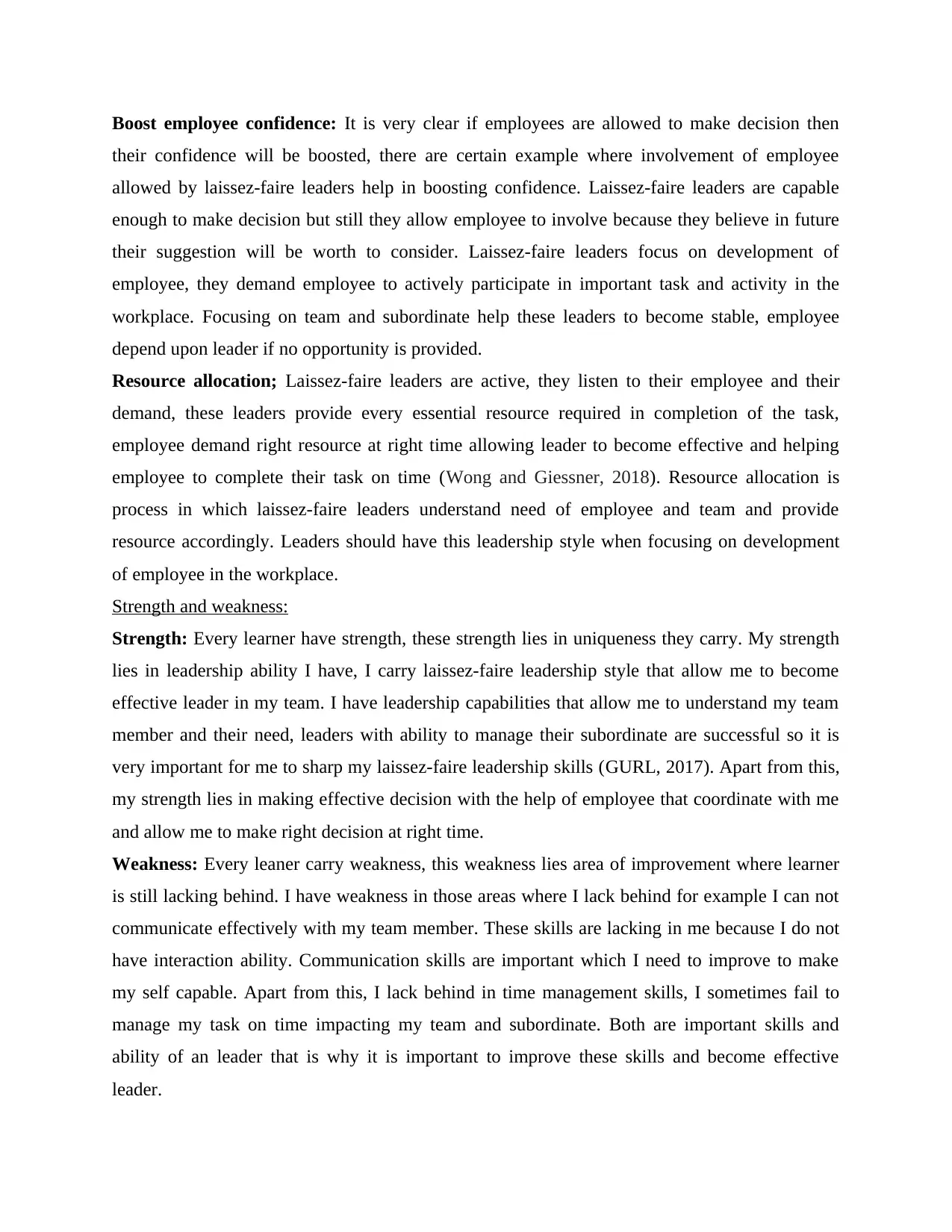
Boost employee confidence: It is very clear if employees are allowed to make decision then
their confidence will be boosted, there are certain example where involvement of employee
allowed by laissez-faire leaders help in boosting confidence. Laissez-faire leaders are capable
enough to make decision but still they allow employee to involve because they believe in future
their suggestion will be worth to consider. Laissez-faire leaders focus on development of
employee, they demand employee to actively participate in important task and activity in the
workplace. Focusing on team and subordinate help these leaders to become stable, employee
depend upon leader if no opportunity is provided.
Resource allocation; Laissez-faire leaders are active, they listen to their employee and their
demand, these leaders provide every essential resource required in completion of the task,
employee demand right resource at right time allowing leader to become effective and helping
employee to complete their task on time (Wong and Giessner, 2018). Resource allocation is
process in which laissez-faire leaders understand need of employee and team and provide
resource accordingly. Leaders should have this leadership style when focusing on development
of employee in the workplace.
Strength and weakness:
Strength: Every learner have strength, these strength lies in uniqueness they carry. My strength
lies in leadership ability I have, I carry laissez-faire leadership style that allow me to become
effective leader in my team. I have leadership capabilities that allow me to understand my team
member and their need, leaders with ability to manage their subordinate are successful so it is
very important for me to sharp my laissez-faire leadership skills (GURL, 2017). Apart from this,
my strength lies in making effective decision with the help of employee that coordinate with me
and allow me to make right decision at right time.
Weakness: Every leaner carry weakness, this weakness lies area of improvement where learner
is still lacking behind. I have weakness in those areas where I lack behind for example I can not
communicate effectively with my team member. These skills are lacking in me because I do not
have interaction ability. Communication skills are important which I need to improve to make
my self capable. Apart from this, I lack behind in time management skills, I sometimes fail to
manage my task on time impacting my team and subordinate. Both are important skills and
ability of an leader that is why it is important to improve these skills and become effective
leader.
their confidence will be boosted, there are certain example where involvement of employee
allowed by laissez-faire leaders help in boosting confidence. Laissez-faire leaders are capable
enough to make decision but still they allow employee to involve because they believe in future
their suggestion will be worth to consider. Laissez-faire leaders focus on development of
employee, they demand employee to actively participate in important task and activity in the
workplace. Focusing on team and subordinate help these leaders to become stable, employee
depend upon leader if no opportunity is provided.
Resource allocation; Laissez-faire leaders are active, they listen to their employee and their
demand, these leaders provide every essential resource required in completion of the task,
employee demand right resource at right time allowing leader to become effective and helping
employee to complete their task on time (Wong and Giessner, 2018). Resource allocation is
process in which laissez-faire leaders understand need of employee and team and provide
resource accordingly. Leaders should have this leadership style when focusing on development
of employee in the workplace.
Strength and weakness:
Strength: Every learner have strength, these strength lies in uniqueness they carry. My strength
lies in leadership ability I have, I carry laissez-faire leadership style that allow me to become
effective leader in my team. I have leadership capabilities that allow me to understand my team
member and their need, leaders with ability to manage their subordinate are successful so it is
very important for me to sharp my laissez-faire leadership skills (GURL, 2017). Apart from this,
my strength lies in making effective decision with the help of employee that coordinate with me
and allow me to make right decision at right time.
Weakness: Every leaner carry weakness, this weakness lies area of improvement where learner
is still lacking behind. I have weakness in those areas where I lack behind for example I can not
communicate effectively with my team member. These skills are lacking in me because I do not
have interaction ability. Communication skills are important which I need to improve to make
my self capable. Apart from this, I lack behind in time management skills, I sometimes fail to
manage my task on time impacting my team and subordinate. Both are important skills and
ability of an leader that is why it is important to improve these skills and become effective
leader.
Paraphrase This Document
Need a fresh take? Get an instant paraphrase of this document with our AI Paraphraser
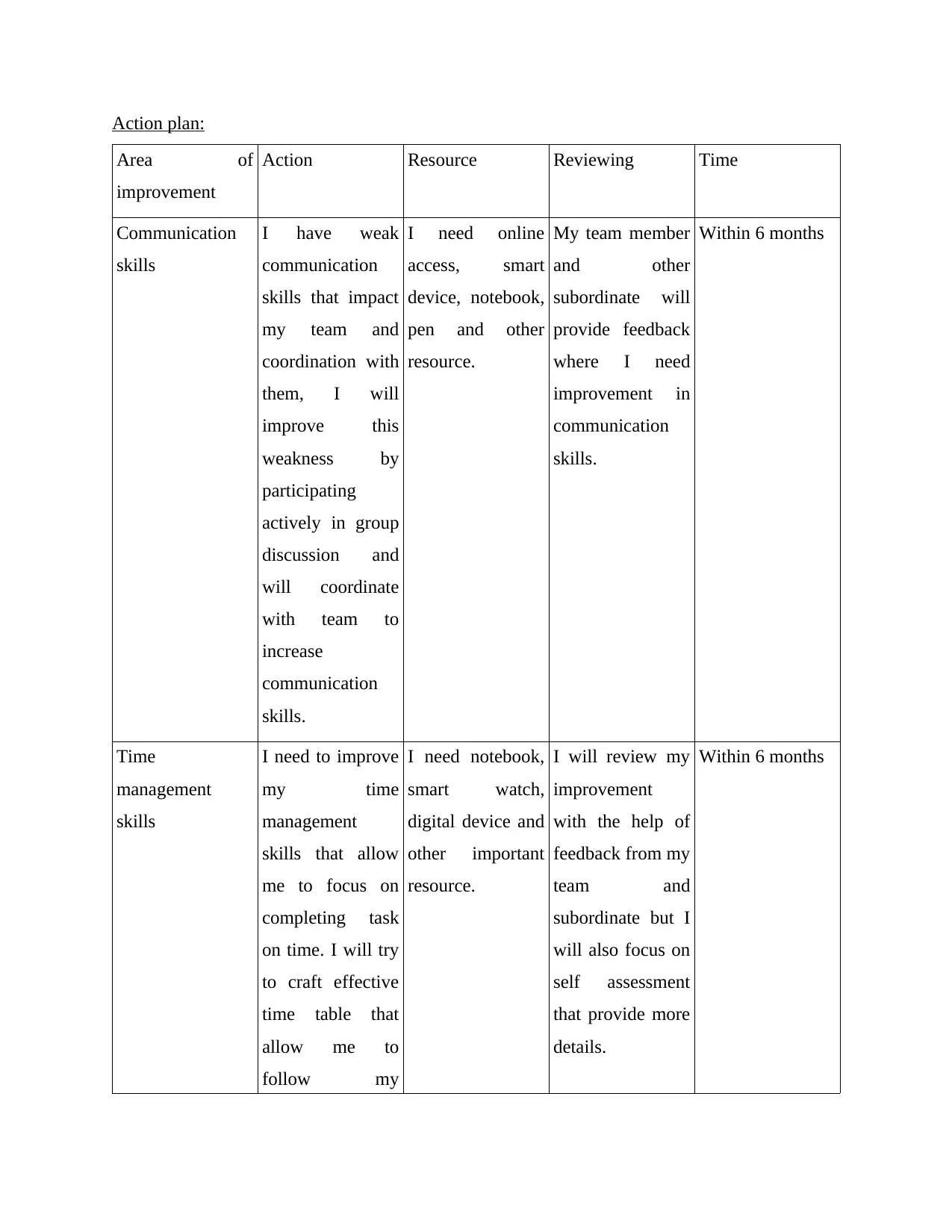
Action plan:
Area of
improvement
Action Resource Reviewing Time
Communication
skills
I have weak
communication
skills that impact
my team and
coordination with
them, I will
improve this
weakness by
participating
actively in group
discussion and
will coordinate
with team to
increase
communication
skills.
I need online
access, smart
device, notebook,
pen and other
resource.
My team member
and other
subordinate will
provide feedback
where I need
improvement in
communication
skills.
Within 6 months
Time
management
skills
I need to improve
my time
management
skills that allow
me to focus on
completing task
on time. I will try
to craft effective
time table that
allow me to
follow my
I need notebook,
smart watch,
digital device and
other important
resource.
I will review my
improvement
with the help of
feedback from my
team and
subordinate but I
will also focus on
self assessment
that provide more
details.
Within 6 months
Area of
improvement
Action Resource Reviewing Time
Communication
skills
I have weak
communication
skills that impact
my team and
coordination with
them, I will
improve this
weakness by
participating
actively in group
discussion and
will coordinate
with team to
increase
communication
skills.
I need online
access, smart
device, notebook,
pen and other
resource.
My team member
and other
subordinate will
provide feedback
where I need
improvement in
communication
skills.
Within 6 months
Time
management
skills
I need to improve
my time
management
skills that allow
me to focus on
completing task
on time. I will try
to craft effective
time table that
allow me to
follow my
I need notebook,
smart watch,
digital device and
other important
resource.
I will review my
improvement
with the help of
feedback from my
team and
subordinate but I
will also focus on
self assessment
that provide more
details.
Within 6 months
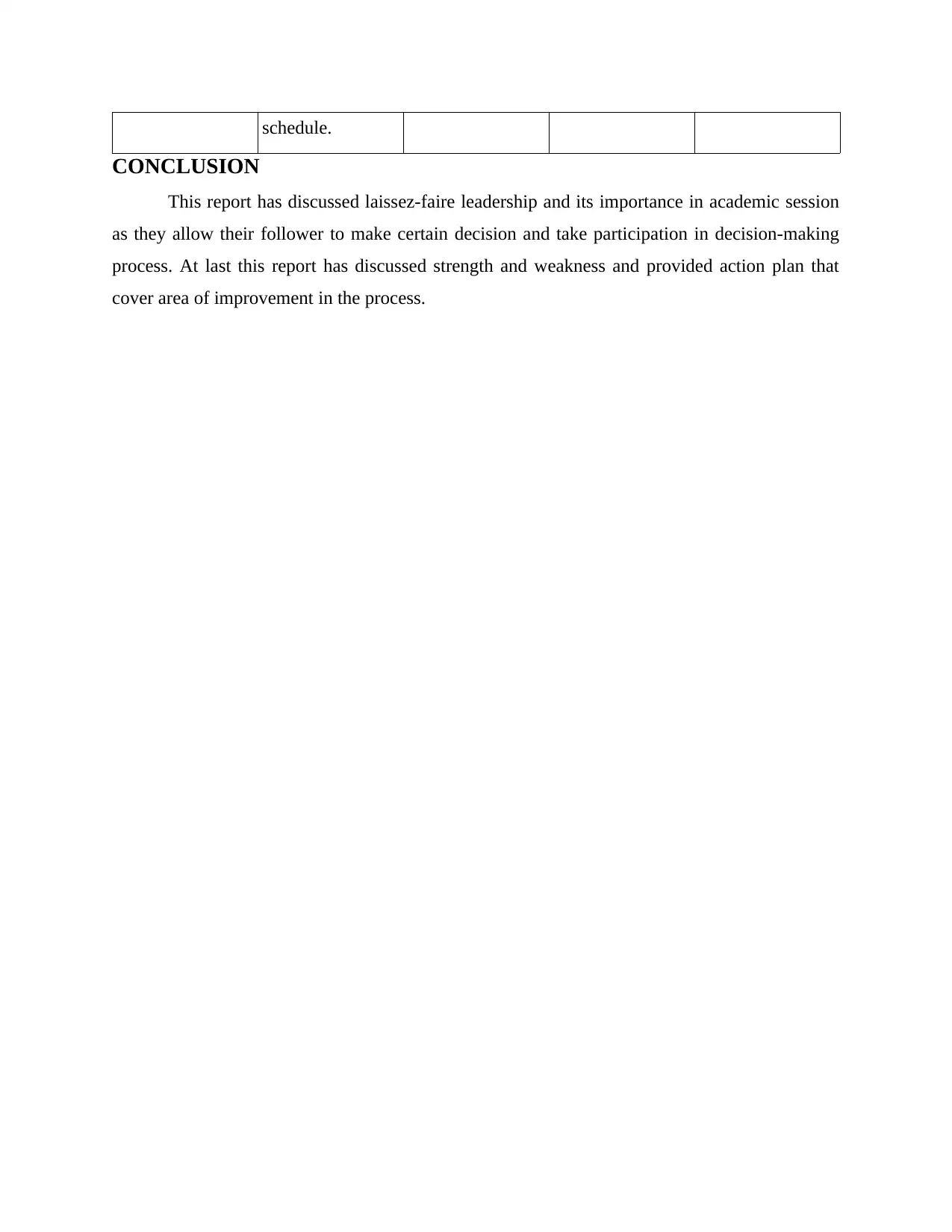
schedule.
CONCLUSION
This report has discussed laissez-faire leadership and its importance in academic session
as they allow their follower to make certain decision and take participation in decision-making
process. At last this report has discussed strength and weakness and provided action plan that
cover area of improvement in the process.
CONCLUSION
This report has discussed laissez-faire leadership and its importance in academic session
as they allow their follower to make certain decision and take participation in decision-making
process. At last this report has discussed strength and weakness and provided action plan that
cover area of improvement in the process.
⊘ This is a preview!⊘
Do you want full access?
Subscribe today to unlock all pages.

Trusted by 1+ million students worldwide
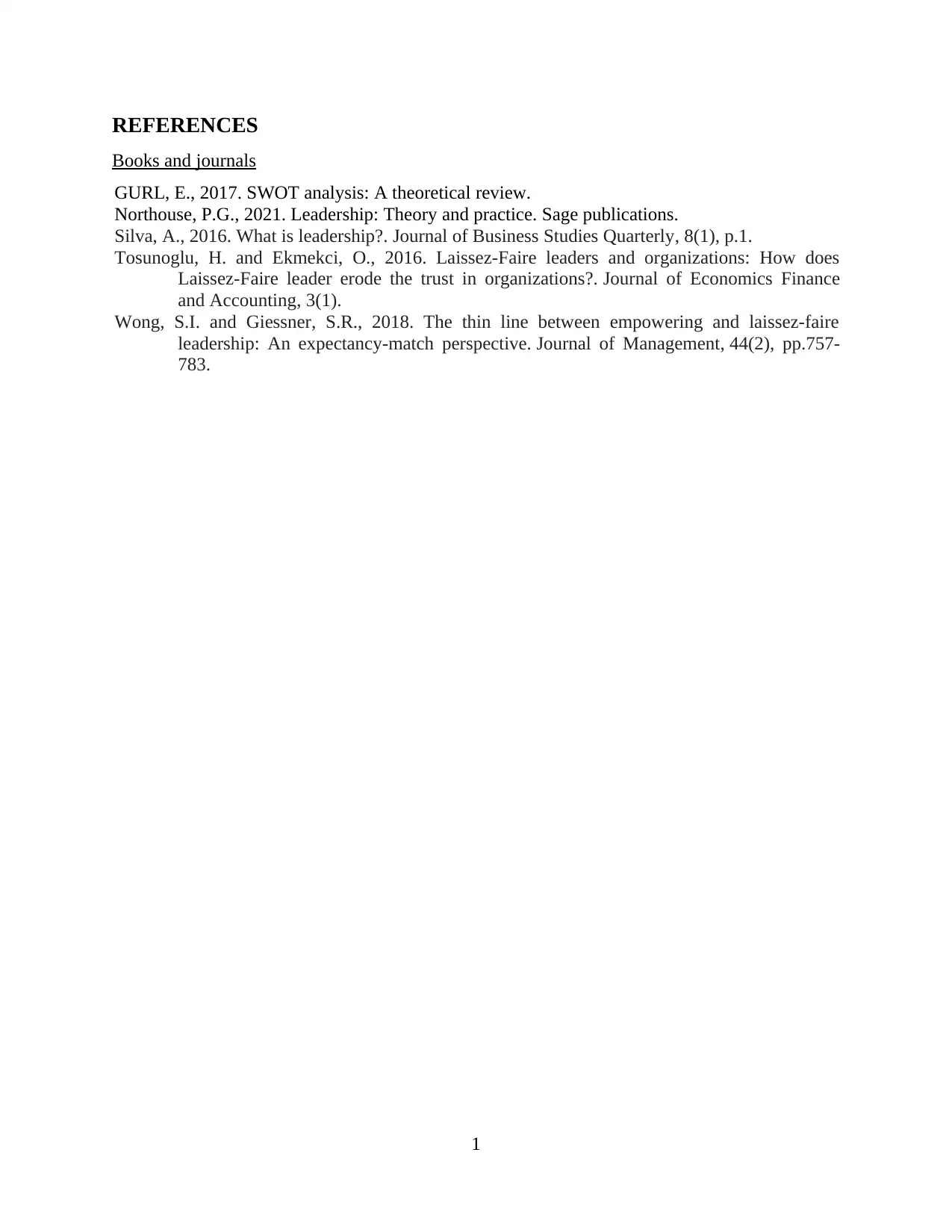
REFERENCES
Books and journals
GURL, E., 2017. SWOT analysis: A theoretical review.
Northouse, P.G., 2021. Leadership: Theory and practice. Sage publications.
Silva, A., 2016. What is leadership?. Journal of Business Studies Quarterly, 8(1), p.1.
Tosunoglu, H. and Ekmekci, O., 2016. Laissez-Faire leaders and organizations: How does
Laissez-Faire leader erode the trust in organizations?. Journal of Economics Finance
and Accounting, 3(1).
Wong, S.I. and Giessner, S.R., 2018. The thin line between empowering and laissez-faire
leadership: An expectancy-match perspective. Journal of Management, 44(2), pp.757-
783.
1
Books and journals
GURL, E., 2017. SWOT analysis: A theoretical review.
Northouse, P.G., 2021. Leadership: Theory and practice. Sage publications.
Silva, A., 2016. What is leadership?. Journal of Business Studies Quarterly, 8(1), p.1.
Tosunoglu, H. and Ekmekci, O., 2016. Laissez-Faire leaders and organizations: How does
Laissez-Faire leader erode the trust in organizations?. Journal of Economics Finance
and Accounting, 3(1).
Wong, S.I. and Giessner, S.R., 2018. The thin line between empowering and laissez-faire
leadership: An expectancy-match perspective. Journal of Management, 44(2), pp.757-
783.
1
1 out of 7
Related Documents
Your All-in-One AI-Powered Toolkit for Academic Success.
+13062052269
info@desklib.com
Available 24*7 on WhatsApp / Email
![[object Object]](/_next/static/media/star-bottom.7253800d.svg)
Unlock your academic potential
Copyright © 2020–2025 A2Z Services. All Rights Reserved. Developed and managed by ZUCOL.





